Scientific theories are often repeated and summarized so often that we forget they are merely “theories,” and not facts. When you think of “the center of the Earth,” you probably picture the classic diagram from your high-school science textbook showing a cross-section of the Earth’s layers like those of an onion: the crust, the upper mantle, the lower mantle, the outer core, and the inner core.
Humankind has only penetrated about 8 miles into the Earth. We've filled in some 3,992 miles with theories.





